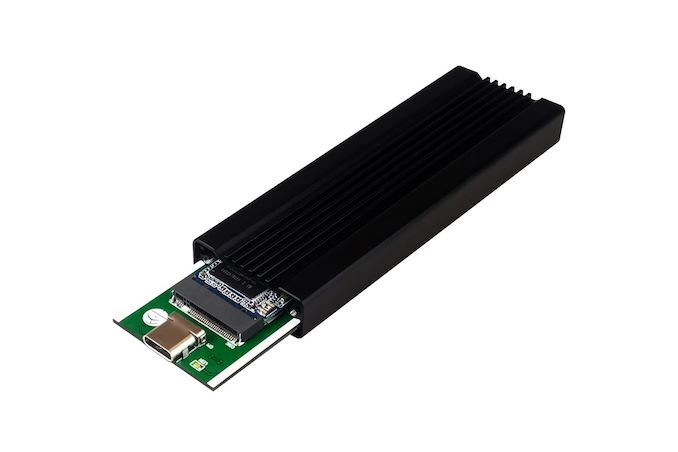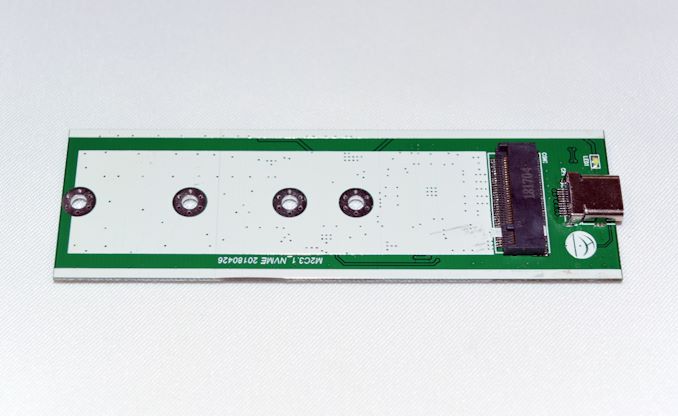MyDigitalSSD M2X M.2 NVMe SSD Enclosure Review - A PCIe to USB Storage Bridge
by Ganesh T S on October 31, 2018 8:00 AM EST- Posted in
- Storage
- SSDs
- USB 3.1
- NVMe
- Type-C
- Storage Bridge
- External SSDs

Storage bridges come in many varieties within the internal and external market segments. USB has become the de-facto standard when it comes to external mass-market storage enclosures. But while there are plenty of options to bridge SATA devices in different form factors to USB, the rapid rise in popularity of NVMe drives has brought about a different challenge. In the premium market, we have many Thunderbolt 3 external SSDs with M.2 NVMe drives inside. However for various reasons, the development of NVMe-to-USB adapters has been another matter.
In fact it's only recently that we've finally seen some progress on this front. JMicron's introduction of a PCIe 3.0 x2 to USB 3.1 Gen 2 bridge chip (JMS583) has enabled Asian OEMs to introduce bus-powered NVMe SSD enclosures with a USB interface, finally enabling relatively cheap USB adapters for NVMe drives. MyDigitalSSD, in turn, is one of the first to bring such a device to the North American market with their M2X External USB 3.1 Gen 2 M.2 NVMe PCIe SSD Enclosure Adapter.
Introduction
The external storage bridges that we have evaluated so far have usually had one or more SATA ports. The most popular uplink port is some sort of USB connection. eSATA as an uplink interface is on the way out. High-end products have Thunderbolt support. The introduction of PCIe to USB bridge chips such as the JMicron JMS583 and the ASMedia ASM2362 have now brought M.2 PCIe slots as a downstream option.
Today's review will take a detailed look at the MyDigitalSSD M2X external USB 3.1 Gen 2 M.2 NVMe PCIe SSD enclosure adapter, an interesting product with a mouthful of a name that's based based on the JMicron JMS583 bridge chip.
In order to ensure compatibility across a wide variety of systems, consumers need to keep the following aspects in mind for M.2 NVMe to USB enclosures and SSDs used inside them:
- Support for UASP (USB-attached SCSI protocol) for better performance (reduced protocol overhead and support for making optimal use of the NVMe command set)
- Support for TRIM to ensure SSDs in the external enclosure can operate optimally in the long run
- Support for S.M.A.R.T passthrough to enable monitoring of the internal NVMe device by the host OS
- Ability of the chosen SSD to expose an active power state that doesn't exceed 4.5W after adding the bridge chip's power consumption into account
The table below presents the detailed specifications and miscellaneous aspects of the various storage bridges we have evaluated so far and how they compare.
| Comparative Storage Bridges Configurations | ||
| Aspect | ||
| Downstream Port | 1x PCIe 3.0 x2 (M.2 NVMe) | 1x SATA III (mSATA) |
| Upstream Port | USB 3.1 Gen 2 Type-C | USB 3.1 Gen 2 Type-C |
| Bridge Chip | JMicron JMS583 | ASMedia ASM1351 |
| Power | Bus Powered | Bus Powered |
| Use Case | M.2 2242 / 2260 / 2280 NVMe SSD Enclosure DIY high-performance, compact, and sturdy portable SSD with a USB flash drive-like form-factor |
mSATA SSD Enclosure DIY high-performance, compact, and sturdy portable SSD with a USB flash drive-like form-factor |
| Physical Dimensions | 99 mm x 42 mm x 13 mm | 73 mm x 38 mm x 9.5 mm |
| Weight (diskless) | 48 grams (without cable) | 60 grams (with Type-C to Type-C cable) |
| Cable | 29.7 cm USB 3.1 Gen 2 Type-C to Type-C 29.7 cm USB 3.1 Gen 2 Type-C to Type-A |
12.7 cm USB 3.1 Gen 2 Type-C to Type-C 11.4 cm USB 3.1 Gen 2 Type-C to Type-A |
| S.M.A.R.T Passthrough | Yes | Yes |
| UASP Support | Yes | Yes |
| TRIM Passthrough | Yes | Yes |
| Price | USD 40 | GBP 50 |
| Review Link | MyDigitalSSD M2X Review | Axtremex Micro SSD Gen2 Review |
The gallery below shows the components of the package as well as teardown pictures of the enclosure. A tep-by-step pictorial guide is provided for the installation of the SSD in the enclosure. A thermal pad that rests against the inside of the grooved side of the enclosure suggests that the thermal performance of the enclosure should be satisfactory. We will be taking a look at that aspect further down in this review.
While easily faster than a SATA III-based enclosure, the performance of the M2X enclosure is none the less capped by two aspects. On the downstream side, the bridge chip only has a PCIe 3.0 x2 link, whereas most NVMe SSDs have an x4 interface (the widest allowed by M.2). This doesn't pose a compatibility problem since M.2 drives can negotiate down just fine, however it does cap their SSD-to-bridge throughput at just under 2GB/sec. .
On the upstream side, the USB 3.1 Gen 2 interface has its own limitations, as it tops out at 10 Gbps. And considering the associated overhead, a practical expectation is around 8 Gbps. This means that a any USB 3.1 enclosure is going to operate at a fraction of a high-end SSD's performance – peaking at around 1GB/sec – though unless you have a high-end NVMe SSD just lying around to begin with, it's going to make a lot more sense to install a cheap x2 SSD instead. The flip side to this being that you do need a reasonably well performing SSD to make good use of such an enclosure, as low-end NVMe drives may struggle to saturate even the limited bandwidth of this kind of enclosure.
Keeping these aspects in mind, we opted to install the 1TB version of the MyDigitalSSD SBX PCIe 3.0 x2 M.2 NVMe SSD in the M2X. This drive should be fast enough to reveal the full capabilities of the bridge chip / enclosure without being held back by too much.

















39 Comments
View All Comments
peterfares - Wednesday, October 31, 2018 - link
I got one of these, it is pretty nice other than it's a bit hard to slide in the drive with the heat pad on it. I got it to be able to pull an NVMe drive out of a computer to read it externally, and because I had a spare 256GB M.2 drive from a computer I upgraded.repoman27 - Wednesday, October 31, 2018 - link
"...the enclosure along with the SSD must stay within the minimum guaranteed USB 2.0 power delivery envelop (900mA @ 5V, corresponding to 4.5W)."Not sure if that's an error or just a typo, but Vbus for USB 2.0 only offers 500 mA @ 5 V, which is 2.5 W. What you quoted is for USB 3.x, and your power measurements more or less bear that out.
Seeing as this is a USB Type-C device, it would be nice if they included a port controller that supported USB Type-C Current. This would allow the drive to draw up to 1.5 A (similar to USB Battery Charging 1.2) or 3.0 A at 5 V if those levels were advertised by the host / upstream port, without the expense of implementing USB Power Delivery. Many ports already support USB BC 1.2, and 7.5 W would be sufficient for most SSD's, and certainly 15 W would be plenty once Type-C Current becomes more common. Dissipating more than 7.5 W with an enclosure that size probably wouldn't be happening though.
These types of bridges look like they're positioned to become the mainstay of affordable, high-performance, external storage. A version that supported USB Type-C current and USB 3.2 Gen 2x2 (20 Gbit/s) along with a well engineered thermal solution would be brilliant.
ganeshts - Thursday, November 1, 2018 - link
Thank you very much for pointing out the error. I have added a few updates in that section clarifying the 2.5W vs. 4.5W power envelop, and how it affects this particular enclosure.vailr - Wednesday, October 31, 2018 - link
Aliexpress offers similar NVMe enclosures with the JMS583 controller chip. "JEYI" and "XT-XINTE" are two brand names offered there, at prices beginning at ~$22 including shipping, direct from China. I have the JEYI branded item, which works ok with a Samsung 960 EVO NVMe drive. Can be configured as a bootable external "Windows to Go" drive. Much faster than a typical USB 3.0 thumb drive.colinstalter - Wednesday, October 31, 2018 - link
I've been wanting to design a three-SSD Thunderbolt 3-based drive. This is a pretty cool product.netmann - Wednesday, October 31, 2018 - link
Nice review!Simple question: can you use this enclosure as a Windows 10 boot drive? If not, why?
vailr - Thursday, November 1, 2018 - link
Yes, Windows can be configured as a bootable external "Windows to Go" drive. Rufus is one example of free software which allows installation of Windows on an external USB device from a standard installation .iso file.netmann - Saturday, November 3, 2018 - link
Thanks. But checking Refus website reveals it only works on USB flash drives (thumb drives) and not on USB external SSD or HDD...vailr - Sunday, November 11, 2018 - link
The Rufus website may be outdated.I'm certain that it does work for preparing a "Windows to Go" boot drive. "Windows to Go" is one of the Rufus menu options, which can be used to prepare a bootable USB thumb drive, a bootable USB 3.0 or USB-C external SSD, spinning hard drive, or what have you. However, you cannot simply install Windows on an external USB drive while the system was booted from a normal Windows installation media.
akvadrako - Monday, November 12, 2018 - link
Not really. It only works for Win2Go, which isn't the same as a full install.It is possible to install Windows on a normal drive and make a sector-by-sector clone, but it requires a fair bit of tinkering and isn't supported.